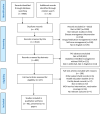A systematic review of home-based records in maternal and child health for improving informational continuity, health outcomes, and perceived usefulness in low and middle-income countries
- PMID: 35925923
- PMCID: PMC9352021
- DOI: 10.1371/journal.pone.0267192
A systematic review of home-based records in maternal and child health for improving informational continuity, health outcomes, and perceived usefulness in low and middle-income countries
Abstract
Background: Evidence shows that a gap in the documentation of patients' past medical history leads to errors in, or duplication of, treatment and is a threat to patient safety. Home-based or patient-held records (HBR) are widely used in low and middle-income countries (LMIC) in maternal and childcare. The aim is to systematically review the evidence on HBRs in LMICs for (1) improving informational continuity for providers and women/families across health care visits and facilities, (2) to describe the perceived usefulness by women/families and healthcare providers, and (3) maternal and child health outcomes of using HBRs for maternal and child health care.
Methods: The protocol was registered in PROSPERO (CRD42019139365). We searched MEDLINE, EMBASE, CINAHL, and Global Index Medicus databases for studies with home-based records from LMICs. Search terms pertained to women or parent-held records and LMICs. Two reviewers assessed studies for inclusion using a priori study selection criteria- studies explaining the use of HBRs in LMIC for maternal and child health care. The included study quality was appraised using the Mixed Methods Appraisal Tool (MMAT). Results from all study designs were summarised narratively.
Results: In total, 41 papers were included in the review from 4514 potential studies. Included studies represented various study designs and 16 countries. The least evaluated function of HBR was information continuity across health care facilities (n = 6). Overall, there were limited data on the usefulness of HBRs to providers and mothers/families. Home-based records were mostly available for providers during health care visits. However, the documentation in HBRs varied. The use of HBRs is likely to lead to improved antenatal visits and immunisation uptake, and skilled birth delivery in some settings. Mothers' knowledge of breastfeeding practices and danger signs in pregnancy improved with the use of HBRs. One randomised trial found the use of HBRs reduced the risk of cognitive development delay in children and another reported on trial lessened the risk of underweight and stunted growth in children.
Conclusion: There is limited literature from LMICs on the usefulness of HBRs and for improving information transfer across healthcare facilities, or their use by women at home. Current HBRs from LMICs are sub-optimally documented leading to poor informational availability that defeats the point of them as a source of information for future providers.
Conflict of interest statement
The authors have declared that no competing interests exist.
Figures
Similar articles
-
Inequalities in ownership and availability of home-based vaccination records in 82 low- and middle-income countries.BMJ Glob Health. 2024 Dec 27;9(12):e016054. doi: 10.1136/bmjgh-2024-016054. BMJ Glob Health. 2024. PMID: 39732475 Free PMC article.
-
Folic acid supplementation and malaria susceptibility and severity among people taking antifolate antimalarial drugs in endemic areas.Cochrane Database Syst Rev. 2022 Feb 1;2(2022):CD014217. doi: 10.1002/14651858.CD014217. Cochrane Database Syst Rev. 2022. PMID: 36321557 Free PMC article.
-
Effectiveness of home-based records on maternal, newborn and child health outcomes: A systematic review and meta-analysis.PLoS One. 2019 Jan 2;14(1):e0209278. doi: 10.1371/journal.pone.0209278. eCollection 2019. PLoS One. 2019. PMID: 30601847 Free PMC article.
-
Fragmented implementation of maternal and child health home-based records in Vietnam: need for integration.Glob Health Action. 2016 Feb 25;9:29924. doi: 10.3402/gha.v9.29924. eCollection 2016. Glob Health Action. 2016. PMID: 26928218 Free PMC article.
-
Understanding women's, caregivers', and providers' experiences with home-based records: A systematic review of qualitative studies.PLoS One. 2018 Oct 4;13(10):e0204966. doi: 10.1371/journal.pone.0204966. eCollection 2018. PLoS One. 2018. PMID: 30286161 Free PMC article.
Cited by
-
Travelling numbers and broken loops: A qualitative systematic review on collecting and reporting maternal and neonatal health data in low-and lower-middle income countries.SSM Popul Health. 2024 Apr 4;26:101668. doi: 10.1016/j.ssmph.2024.101668. eCollection 2024 Jun. SSM Popul Health. 2024. PMID: 38645668 Free PMC article. Review.
-
An audit of completeness of Road to Health Booklet at a community health centre in South Africa.Afr J Prim Health Care Fam Med. 2024 Dec 18;16(1):e1-e8. doi: 10.4102/phcfm.v16i1.4654. Afr J Prim Health Care Fam Med. 2024. PMID: 39846111 Free PMC article.
-
Inequalities in ownership and availability of home-based vaccination records in 82 low- and middle-income countries.BMJ Glob Health. 2024 Dec 27;9(12):e016054. doi: 10.1136/bmjgh-2024-016054. BMJ Glob Health. 2024. PMID: 39732475 Free PMC article.
-
Postdischarge health information tools and information needs for mothers of vulnerable newborns in low- and middle-income countries: a scoping review.BMJ Open. 2025 Feb 26;15(2):e082824. doi: 10.1136/bmjopen-2023-082824. BMJ Open. 2025. PMID: 40010811 Free PMC article.
References
-
- Organization. WH. Sexual and reproductive health. Standards for improving quality of maternal and newborn care in health facilities 2016 [http://www.who.int/reproductivehealth/publications/maternal_perinatal_he... accessed 10/09 2019].
Publication types
MeSH terms
Grants and funding
LinkOut - more resources
Full Text Sources
Medical
Miscellaneous


